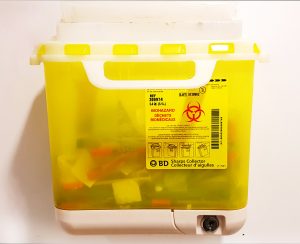1.3.6 Waste Removal
Proper waste collection and disposal is a key element in infection control and helps to prevent release of chemical and biological hazards into the environment. In your role, you will have duties that may involve assisting with the removal of waste from the client area.
There are many different categories of waste, and it’s important that you are aware that these different categories require different methods of disposal. Please review the following list carefully:
- General waste is waste that does not include any of the categories below. It is discarded in the room waste container with a liner.
- Chemical waste includes solvents, disinfectants, sterilants, batteries, broken mercury thermometers, and any other substance that may be acidic or toxic. It is discarded in special containers in the soiled utility room.
- Infectious waste includes infection coverings/dressings. It is discarded inside a plastic bag into the container marked with the biohazard symbol because it contains body fluids/substances.
- Sharps waste is used needles and syringes. These are disposed in well labeled puncture-proof containers (either high density plastic or metal) with tamperproof covers. These containers may be attached to the wall in some unit rooms.

Waste that is removed from a room in isolation must be double-bagged. This process involves one person on the inside of the room with the soiled waste bag, and one person outside of the room, wearing gloves and holding a clean open waste bag. The soiled bag is placed into the clean bag being held. The person secures the top of the bag for disposal. Then, you will follow your employer’s policy on waste removal.
Practice Makes Perfect
Reinforce your learning by dragging the type of waste to the correct method of disposal:
As with all situations where you may come in contact with body fluids, you will wash your hands and don gloves before assisting with waste removal of any kind. After discarding the waste bag into the proper receptacle, always perform hand hygiene.
Key Takeaway
For detailed discussion of waste disposal procedures in much more detail, please consult Best Practices for Environmental Cleaning for Prevention and Control of Infections in All Health Care Settings, 3rd Edition (2018).
Media Attributions
- “Sharps container” by Indrid__Cold is licensed under CC BY-SA 2.0

